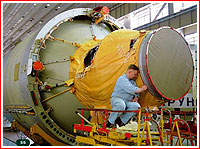The third stage of Proton rocket (original) (raw)
Searching for details:
The author of this page will appreciate comments, corrections and imagery related to the subject. Please contact Anatoly Zak.
Proton's third stage
The third stage was added to the Proton rocket after four launches of its two-stage version. It has remained a part of the historic launch vehicle ever since.
Previous chapter: Stage II of the Proton rocket

Designated 8S812KM, the third stage of the Proton rocket is equipped with a single RD-0213 engine, largely borrowed from the rocket's second stage and a four-chamber steering engine RD-0214. Together they form a propulsion system known as RD-0212. Each chamber on RD-0214 can rotate up to 45 degrees to steer the rocket in flight.
A triple redundant closed-loop digital avionics system mounted in the Proton’s third stage is responsible for flight control of first three stages of the launch vehicle.
At the end of the operation of the third stage, the main engine is cut off first, followed by the shutdown of the steering engine, whose low thrust enables to fine tune the final velocity of the payload based on the latest real-time data obtained during the flight.
The third stage completes its firing at an altitude of around 150 kilometers, releasing its payload usually slightly less than 10 minutes into the flight. The total burn time of the third stage lasts around four minutes.
Four 15D4-00 solid motors installed on its lower section of the stage fire backwards at T+582.2 seconds in flight (on the Proton-M variant) to push the stage away from the payload. The the spent stage then falls into the Pacific Ocean.
In the course of its operational history, the third stage was lightened, thanks to the replacement of the metal skeleton of its aft section with a carbon-based panels.
Next chapter: Block D upper stage
Technical specifications of the third stage of the original Proton-K rocket:
| Dry mass | 4,570 kilograms |
|---|---|
| Fueled mass | 68,660 kilograms |
| Liftoff mass | 68,650 kilograms |
| Oxidizer mass | 32,800 kilograms |
| Fuel mass | 12,940 kilograms |
| The end mass | 23,500 kilograms |
| Liftoff to end mass ratio | 2.92 |
| Propulsion system thrust to liftoff mass ratio | 0.90 |
| Burn time | 234.0 seconds |
Technical specifications of the second stage of the original UR-500, Proton-K and Proton-M rockets:
| - | Proton-K | Proton-M |
|---|---|---|
| Diameter | 4.1 meters | 4.1 meters |
| A total length of the third stage | - meters | - meters |
| Propulsion system | RD-0212 (made of one RD-0213 and one RD-0214) | RD-0212 (made of one RD-0213 and one RD-0214) |
| A total thrust of the third stage in vacuum | 583 + 31 meganewtons | 583 kilonewtons |
| A total dry mass of the second stage | 4,185 kilograms | - kilograms |
| A total mass of propellant in the third stage | 46,562 kilograms | - kilograms |
| Separation time | T+581.4 seconds* | T+585.5 seconds* |
| Separation speed | 7,344.3 meters per second | 7,195.3 meters per second |
| Separation altitude | 146.53 kilometers* | 149.1 kilometers* |
| Impact site latitude | - | 31 degrees 55 minutes North |
| Impact site longitude | - | 153 degrees 45 minutes East |
*Varies depending on a particular mission
Page author: Anatoly Zak; Last update:May 31, 2019
All rights reserved

The third stage of the Proton rocket during its assembly in Moscow. Credit: GKNPTs Khrunichev
An exterior of the third stage on the Proton rocket. Click to enlarge. Copyright © 2000 Anatoly Zak
A 1 to 5 scale model of the RD-0212/0214 engine. Click to enlarge. Copyright © 2011 Anatoly Zak


)
)